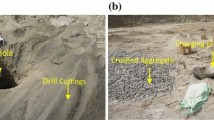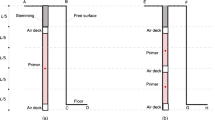Abstract
Stemming is an essential blast design parameter, and inadequate stemming length/materials impact directly, among others, rock fragmentation, backbreak, flyrock, and ground vibration. This study evaluated the impact of various stemming materials such as drill cuttings (fine cuttings), angular aggregates (3–7 mm size) and synthetic rubber-assisted stemming (rubber plug) on blast efficiency in surface mines. From the trial blasts, it was found that stemming plugs and angular stone chips of proper sizes (3–7 mm) were very much effective in holding the gas energy in the stemming column/blast hole and in reducing the generation of flyrock (in many trial blasts no flyrock was seen, only more throw of the material toward free face). After conducting the trial blasts near structures (50 m range), it was found that these changes increased minor ground vibration levels near a distance up to 50 m compared to normal drill cuttings due to the high gas pressure created by the plug. However, after 50 m, the vibration attenuation followed as normal blasting. The usage of the stemming plug helped in reducing the backbreak generation for the stability of the highwall, and it also reduced the fragmentation sizes up to 53%. Reduction in fragmentation sizes for the limestone mine, stone mine, and bauxite mine helped in reducing the crushing cost and loading cycle time. In multiple instances, the average backbreak and flyrock were reduced from 2.05 to 0.74 m and from 52.7 to 19.84 m, which showed 55.57% and 61.09% deduction, respectively.














Similar content being viewed by others
References
Abdollahisharif, J., Bakhtavar, E., & Nourizadeh, H. (2016a). Monitoring and assessment of pollutants resulting from bench-blasting operations. Journal of Mining and Environment, 7(1), 109–118.
Abdollahisharif, J., Bakhtavar, E., & Nourizadeh, H. (2016b). Green biocompatible approach to reduce the toxic gases and dust caused by the blasting in surface mining. Environmental Earth Sciences, 75(3), 1–12.
Agrawal, A., Choudhary, B. S., & Murthy, V. M. S. R. (2021). Seismic energy prediction to optimize rock fragmentation: A modified approach. International Journal of Environmental Science and Technology. https://doi.org/10.1007/s13762-021-03753-w
Armaghani, D. J., Mahdiyar, A., Hasanipanah, M., Faradonbeh, R. S., Khandelwal, M., & Amnieh, H. B. (2016). Risk assessment and prediction of flyrock distance by combined multiple regression analysis and Monte Carlo simulation of quarry blasting. Rock Mechanics and Rock Engineering, 49(9), 3631–3641.
Bakhtavar, E., Abdollahisharif, J., & Ahmadi, M. (2017). Reduction of the undesirable bench-blasting consequences with emphasis on ground vibration using a developed multi-objective stochastic programming. International Journal of Mining, Reclamation and Environment, 31(5), 333–345.
Bakhtavar, E., Abdollahisharif, J., & Mohammadi, D. (2022). Analysis and improvement of blasting operation in porphyry, diorite dyke, and trachyte Sungun zones: In-situ investigations. International Journal of Mining and Geo-Engineering, 56(1), 19–24.
Bakhtavar, E., Hosseini, S., Hewage, K., & Sadiq, R. (2021a). Air pollution risk assessment using a hybrid fuzzy intelligent probability-based approach: Mine blasting dust impacts. Natural Resources Research, 30(3), 2607–2627.
Bakhtavar, E., Sadiq, R., & Hewage, K. (2021b). Optimization of blasting-associated costs in surface mines using risk-based probabilistic integer programming and firefly algorithm. Natural Resources Research, 30(6), 4789–4806.
Cevizci, H., & Ozkahraman, H. T. (2012). The effect of blast hole stemming length to rockpile fragmentation at limestone quarries. International Journal of Rock Mechanics and Mining Sciences, 53, 32–35.
Cevizci, H. (2011). A newly developed plaster stemming method for blasting. Journal of South African Institute of Mining and Metallurgy, 112(12), 1071–1078.
Choudhary, B. S., Agrawal, A., & Chandrahas, N. S. (2017). Drilling rows vis-a-vis rock fragmentation and muckpile parameters in surface blast. In National Conference on Challenges in Environment Management: Mines and Industries (CEMMI -17), April (pp. 45–58).
Choudhary, B. S., Agrawal, A., & Arora, R. (2021). Stemming material and Inter-row delay timing effect on blast results in limestone mines. Sadhana - Academy Proceedings in Engineering Sciences, 46(1), 17–24.
Choudhary, B. S., & Rai, P. (2013). Stemming plug and its effect on fragmentation and muckpile shape parameters. International Journal of Mining and Mineral Engineering, 4(4), 296–311.
Dobrilović, M., Ester, Z., & Janković, B. (2005). Measurement in blast hole stem and influence of stemming material on blasting quality. Rudarsko Geolosko Naftni Zbornik, 17, 47–53.
Floyd, J. L. (1999). Explosive energy relief--the key to controlling overbreak. In Procs. Int. Conf. Explo (Vol. 99, pp. 147–153).
Ghasemi, E., Sari, M., & Ataei, M. (2012). Development of an empirical model for predicting the effects of controllable blasting parameters on flyrock distance in surface mines. International Journal of Rock Mechanics and Mining Sciences, 52, 163–170.
Hagan, T. N. (1983). The influence of controllable blast parameters on fragmentation and mining costs. In Proceedings of the 1st international symposium on rock fragmentation by blasting (Vol. 1, pp. 31–32).
Hasanipanah, M., Jahed, D., Hassan, A., & Amnieh, B. (2017). Application of PSO to develop a powerful equation for prediction of flyrock due to blasting. Neural Computing and Applications, 28, 1043–1050.
Hosseini, S., Monjezi, M., & Bakhtavar, E. (2022). Minimization of blast-induced dust emission using gene-expression programming and grasshopper optimization algorithm: A smart mining solution based on blasting plan optimization. Clean Technologies and Environmental Policy. https://doi.org/10.1007/s10098-022-02327-9
Joslin, R. D. (1982). Effect of stemming variations in open pit blasting- a laboratory study. University of Nevada Reno.
Karakus, D., Onur, A. H., Konak, G., & Kose, H. (2003). Application of stemming plugs and a case study in a limestone quarry. In 18 International Mining Congress and Exhibition of Turkey (IMCET2003).
Konya, C. J. (2003). Rock Blasting and overbreak control. National Highway Institute.
Konya, C. J., & Walter, E. J. (1990). Surface blast design. Prentice-Hall.
Kumar, S., & Piyush, S. (2015). Investigation of crushed aggregate as stemming material in bench blasting: A case study. Geotechnical and Geological Engineering, 33(6), 1449–1463.
Lopez Jimeno, C., López Jimeno, E., & Carcedo, F. J. A. (1995). Drilling and blasting of rocks. Rotterdam Books.
Maheshwari, P., Murmu, S., & Verma, H. K. (2021). Modeling of Blast Induced Damage Distance for Underground Tunnels. In Proceedings of the Indian Geotechnical Conference 2019 (pp. 617–626).
Mohammadi Azizabadi, H. R., Mansouri, H., & Fouché, O. (2014). Coupling of two methods, waveform superposition and numerical, to model blast vibration effect on slope stability in jointed rock masses. Computers and Geotechnics, 61, 42–49.
Monjezi, M., Ahmadi, Z., Varjani, A. Y., & Khandelwal, M. (2013). Backbreak prediction in the Chadormalu iron mine using artificial neural network. Neural Computing and Applications, 23(3–4), 1101–1107.
Monjezi, M., & Dehghani, H. (2008). Evaluation of effect of blasting pattern parameters on backbreak using neural networks. International Journal of Rock Mechanics and Mining Sciences, 45(8), 1446–1453.
Monjezi, M., Rizi, S. M. H., Majd, V. J., & Khandelwal, M. (2014). Artificial neural network as a tool for backbreak prediction. Geotechnical and Geological Engineering, 32(1), 21–30.
Mpofu, M., Ngobese, S., Maphalala, B., Roberts, D., & Khan, S. (2021). The influence of stemming practice on ground vibration and air blast. Journal of the Southern African Institute of Mining and Metallurgy, 121(1), 1–10.
Murmu, S., Maheshwari, P., & Verma, H. K. (2018). Empirical and probabilistic analysis of blast-induced ground vibrations. International Journal of Rock Mechanics and Mining Sciences, 103, 267–274.
Oliver, P. H. (2003). Changes to drill pattern and adequate inter-row delay time improve blasting performance. CIM Bulletin, 96(1071), 60–65.
Ozcelik, M. (2018). Back analysis of ground vibrations which cause cracks in buildings in residential areas Karakuyu (Dinar, Afyonkarahisar, Turkey). Natural Hazards, 92(1), 497–509.
Rai, P., & Baghel, S. S. (2004). Investigation of firing patterns on fragmentation in an Indian opencast limestone mine. Quarry Management, 31(2), 33–38.
Rai, P., & Choudhary, B. S. (2008). A firing pattern for generating free face in a limestone Quarry—A case study. The Journal of Institute of Engineers (India), Mining Engineering issue, 88, 3–8.
Rai, P. (2002). Evaluation of the effects of some blast design parameters on fragmentation in opencast mines. Ph.D. thesis, Banaras Hindu University, Varanasi.
Rai, P., Imperial, F. L., & Choudhary, B. S. (2006). A pattern for improvement. Quarry Management Journal, Special issue on “Drilling & Blasting,” Sept, 23–30.
Raina, A. K., Choudhary, P. B., Ramulu, M., Chakraborty, A. K., Dudhankar, A. S., Udpikar, V., et al. (2002). FRAGALYST—An indigenous digital image analysis system for grain size measurements in mines. Journal of Geological Society of India, 59(6), 561–569.
Sanchidrián, J. A., Segarra, P., & López, L. M. (2007). Energy components in rock blasting. International Journal of Rock Mechanics and Mining Sciences, 44(1), 130–147.
Sari, M., Ghasemi, E., & Ataei, M. (2014). Stochastic modeling approach for the evaluation of backbreak due to blasting operations in open pit mines. Rock Mechanics and Rock Engineering, 47(2), 771–783.
Sarma, K. S. (1994). Models for assessing the blasting performance of explosives. The University of Queensland.
Sazid, M. (2014). Investigating the role of effective stemming in engineering blasting operations for open-pit mines. Ph.D Thesis, Indian Institute of Technology Bombay.
Schmidt, M. F. C., Szucs, A., & Worsey, P. (2000). Use of water stemming for rock excavation and splitting. ISEE, 2, 183–190.
Smith, N. S. (1976). Burden-rock stiffness and its effect on fragmentation in bench blasting. Ph.D Thesis, Missouri University of Science and Technology.
Acknowledgments
The author is indebted toward the excellent cooperation and support provided by the entire operational crew, staff and management of the mines during the field studies and data collection.
Funding
This research received external grants/funding from the F. No. 14/15/2015-Metal IV Ministry of Mines, India.
Author information
Authors and Affiliations
Corresponding author
Ethics declarations
Conflict of Interest
The author(s) declared no potential conflicts of interest with respect to the research, authorship, and/or publication of this article.
Rights and permissions
Springer Nature or its licensor holds exclusive rights to this article under a publishing agreement with the author(s) or other rightsholder(s); author self-archiving of the accepted manuscript version of this article is solely governed by the terms of such publishing agreement and applicable law.
About this article
Cite this article
Choudhary, B.S., Agrawal, A. Minimization of Blast-Induced Hazards and Efficient Utilization of Blast Energy by Implementing a Novel Stemming Plug System for Eco-Friendly Blasting in Open Pit Mines. Nat Resour Res 31, 3393–3410 (2022). https://doi.org/10.1007/s11053-022-10126-8
Received:
Accepted:
Published:
Issue Date:
DOI: https://doi.org/10.1007/s11053-022-10126-8




